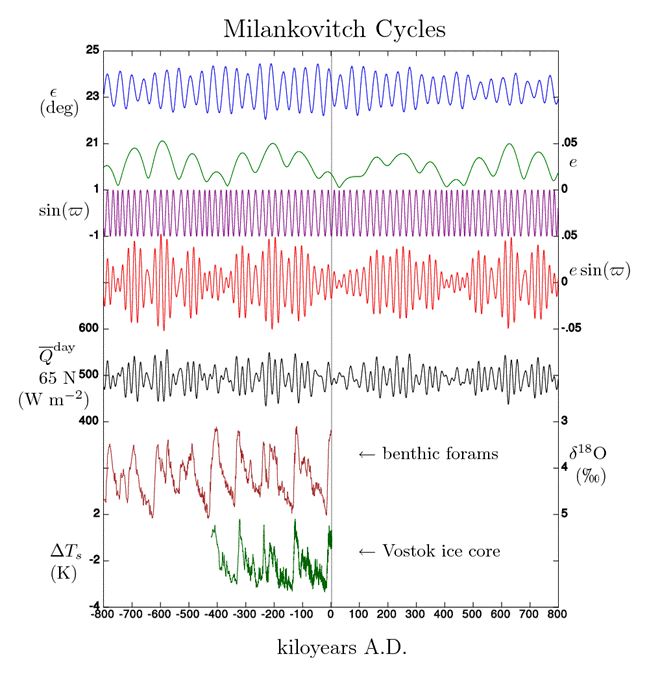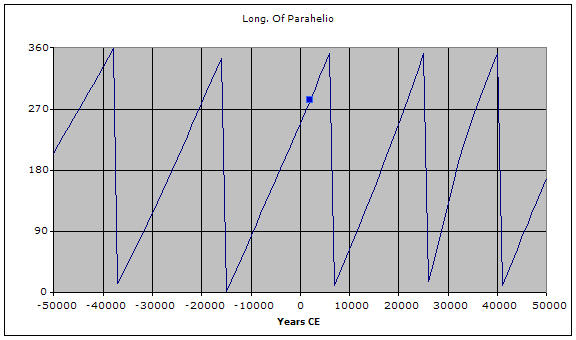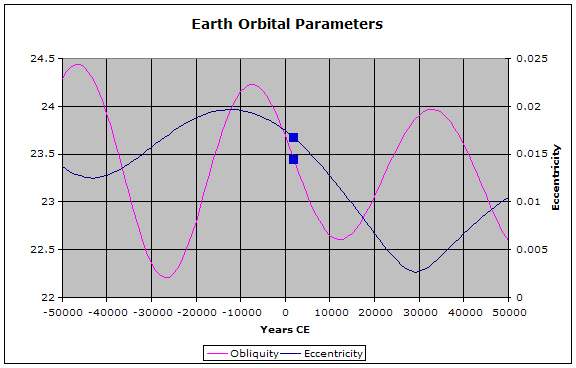Milankovic Cycles and Climate Change
Is it distance from the sun, or length of summer?
By Ed Caryl
A draft paper by Dr. James Hansen and Dr. Makiko Sato triggered a rebuttal by Dr. Martin Hertzberg on WUWT. The Hansen paper made a claim that weaker insolation in the Northern Hemisphere (NH) due to distance from the sun in NH winter should lead to cooling, but that this is offset by increasing CO2.
The Dr. Hertzeberg rebuttal claimed that the warming was due to the longer length of summer in the NH. Both are wrong! Both are victims of Confirmation Bias, seeing only data that confirms their beliefs.
It seemed a little strange that the Hansen paper was written for a conference in Milankovic’s honor, yet the paper does not contain the famous diagram illustrating the Milankovic Cycle (or Milankovitch, both spellings are common in the literature), nor does the Hertzberg rebuttal. Here it is:
Figure 1. Source: Wikipedia Commons
The important part of this chart, and the reason both authors are wrong, is the black plot in the lower center of the chart, (that part of the plot is shown again below) the insolation per day at °65 N latitude. If the scale of this plot were anomaly, instead of absolute value, the anomaly would be slightly negative. The insolation change due to the length of summer and the distance from the sun are almost exactly canceling, and the insolation is not going to change very much for the next 20,000 years.
Figure 2. The blue dot is the current date. Source: Wikipedia Commons
The position in our orbit where we are closest to the sun is called the parahelion point. The tilt of the earth’s axis is related to the parahelion by a relationship known as the “longitude of the parahelion”. The °360-°0 point is where the Vernal Equinox (1st day of Spring) and the parahelion coincide. If you divide the °360 by 4 (=°90) you see that the parahelion will be in spring from °0 to °90, summer from °90 to °180, autumn from °180 to °270, winter from °270 to °360. Right now we are at °283 and the parahelion happens on the 3rd of January.
Figure 3. Plot of the Longitude of the Parahelion point. Plotted from NASA data. The year 2000 is marked by the blue square. You can see that in the year 12,000, 10,000 years from now, we will be closest to the sun in NH mid-summer.
Will this lead to warming in mid-summer? No, because the earth reaches a point of minimum axial tilt at that time, and rapidly decreasing orbital eccentricity (as eccentricity reaches minimum, the orbit approaches a perfect circle) will make the reduced distance from the sun in summer much less important. See the next chart. Again, the current date is the blue squares.
Figure 4. Plot of Obliquity (Earth axial tilt) and orbital eccentricity (deviation from a circle). Plotted from NASA data obtained here.
When will the next ice age be?
One of the comments to the Hertzberg article in WUWT asked, “When will the next ice age will begin?” Answer, not for a while yet. From Wikipedia: “An often-cited 1980 study by Imbrie and Imbrie determined that, ‘Ignoring anthropogenic and other possible sources of variation acting at frequencies higher than one cycle per 19,000 years, this model predicts that the long-term cooling trend which began some 6,000 years ago will continue for the next 23,000 years.’[16]”
All these orbital cycles are much too long and gradual to account for late 20th Century warming. That warming is due to short-term solar output changes, solar magnetic field influence on galactic cosmic rays changing cloud cover, and ocean cycles.
You can see in Figure 2 that the next negative swing in NH insolation is over 50 thousand years in the future, and the next really negative swings are over 100 thousand years off. Even if we cool for the next 23,000 years, it should not get cool enough to trigger an ice age… unless the sun does something really strange.










“Even if we cool for the next 23,000 years, it should not get cool enough to trigger an ice age… unless the sun does something really strange.”
That which we ‘know’ does not scare us (much). It’s the BoogyMan under the bed that makes us hide under the sheet and bite our nails to the quick. (On that possible cooling for the next 23,000 years, for some strange reason it wouldn’t surprise me. I don’t think we know as much as we think we know;-)
Tamino does a good piece on this issue as well.
http://tamino.wordpress.com/2011/01/25/milankovitch-cycles/
Tamino’s rebuttal is crap. As I have posted elsewhere:
Bart… Did you even read the whole post by Tamino? By the sound of your comment you did not.
Rob – You saw my comments at WUWT. I did the same math as Tamino. The math says there is no difference. But, Tamino wasn’t content with that. He then had to assert that, nevertheless, the melt was greater because midsummer’s day was hotter. It was a complete non-sequitur.
Maybe YOU need to read what he wrote again.
Meanwhile, if I read Ed aright, Hansen was wrong additionally because the change in orbital eccentricity cancels out any putative cooling (I am assuming, Ed, that the decrease in eccentricity means a decrease in aphelion, since increasing perihelion would require an increase in orbital energy, and natural systems in steady state generally lose, rather than gain, energy?)
You have misread Tamino’s response. To quote: “Even though you get exactly the same total solar energy over the entire year, the precession cycle affects when you get that energy during the year.” So Tamino explicitly points out that a cold summer is not equivalent to a warm summer. It is the total insolation during above-freezing summer days at high latitude that matters. See Huybers 2006.